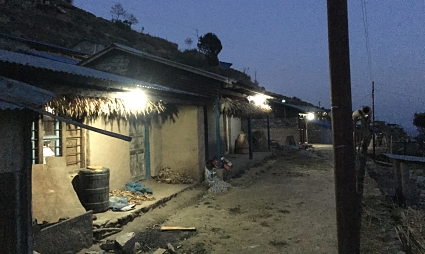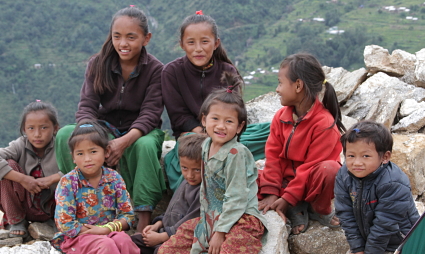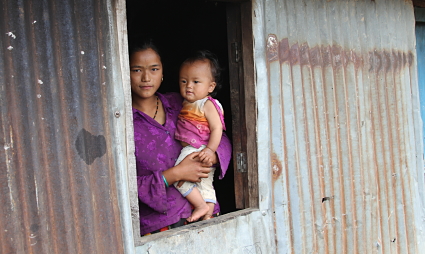Background:
 Perched on a mountainside to the northeast of Kathmandu, Nepal lies Dhapsung, a small off-grid village home to 200 Tamang people. Community members in Dhapsung depend on agriculture for a living. They grow millet, corn and other crops and dry them at home, then walk two hours to the nearest grinding mill to process them. Families also have water buffalos, cows, goats and chickens. Many families have at least one family member working in the Middle East or India in hotels, as cab drivers, or on construction sites who send back remittances to support their families. Dhapsung is the last permanent human settlement in this watershed of the Sindhupalchok district. In the rainy season, it takes four hours to drive then another four hours to walk on dirt paths to reach the village from Kathmandu.
Perched on a mountainside to the northeast of Kathmandu, Nepal lies Dhapsung, a small off-grid village home to 200 Tamang people. Community members in Dhapsung depend on agriculture for a living. They grow millet, corn and other crops and dry them at home, then walk two hours to the nearest grinding mill to process them. Families also have water buffalos, cows, goats and chickens. Many families have at least one family member working in the Middle East or India in hotels, as cab drivers, or on construction sites who send back remittances to support their families. Dhapsung is the last permanent human settlement in this watershed of the Sindhupalchok district. In the rainy season, it takes four hours to drive then another four hours to walk on dirt paths to reach the village from Kathmandu.
The residents of Dhapsung have no access to electricity from the national electric grid due to the village’s remote mountainous location. The village had a 3kW pico hydro system that powered basic lighting but it was completely destroyed in the 2015 earthquakes. After the earthquake, nonprofit Digo Bikas Institute (DBI) installed a small DC-only solar nanogrid bringing lights to the homes in the village, but the system was very limited with little capacity for growth and did not provide AC electricity to the homes. Before the pico hydro plant, villagers had small solar lights called solar tukkis and burned kerosene lamps, pine wax and pit fires to light their homes during the night.
In April 2015, Nepal experienced a major earthquake that killed 8,669 people, injured 16,808 people, and destroyed approximately 288,793 buildings all over Nepal. Sindhupalchok was one of the most affected districts in Nepal with 3,660 reported deaths, out of which 12 people were from Dhapsung village. Almost all of the houses in Dhapsung that were made from mud-stone walls and slate roofs in the village were turned into ruins.
After learning about the village's need for reliable electricity from local partners Gham Power and DBI in Nepal, GRID Alternatives launched a campaign called Power up Nepal to raise funds to bring a microgrid that would provide the entire village with reliable AC electricity to Dhapsung in 2016.
The Project:
 In September 2016, GRID Alternatives staff and volunteers installed a 15.75kW ground-mounted solar microgrid in Dhapsung together with Gham Power, DBI, Beyul Travel & Treks, Nepal Wireless and village members. After the devastating earthquakes, the microgrid came as a welcomed surprise to the villagers who were mourning the death of their family members. People were excited and ready to contribute anything they could to support the project. After many community meetings and conversations with all the stakeholders, the project was ready to be installed.
In September 2016, GRID Alternatives staff and volunteers installed a 15.75kW ground-mounted solar microgrid in Dhapsung together with Gham Power, DBI, Beyul Travel & Treks, Nepal Wireless and village members. After the devastating earthquakes, the microgrid came as a welcomed surprise to the villagers who were mourning the death of their family members. People were excited and ready to contribute anything they could to support the project. After many community meetings and conversations with all the stakeholders, the project was ready to be installed.
Gham Power and GRID staff led the system installation with 10 international travelers who learned about installing a microgrid, the importance of sustainable development practices, and Nepali culture. Digo Bikas Institute took the lead with facilitating community dialogue, business training for the Women’s Group who would manage the income from the microgrid, and explored small business opportunities with the residents to generate more local income. Nepal Wireless installed a wifi tower near the village for remote system monitoring, and Beyul Travel & Treks managed logistics for the volunteers during and after the project. Nonprofit Empower Generation was hired to train women how to sell solar lamps to nearby villages.
Community participation before and during the solar installation was essential and included digging of holes and erecting the power poles, carrying industrial leadacid batteries, solar panels, and power poles to the community, preparing a welcome ceremony for the installation group, and being available to answer questions during the project.
The solar system was designed to provide reliable electricity to 42 households in the village, the elementary school, to provide street lighting, and to power a grain-mill and a carpentry shop in two of the homes. A major assumption GRID and partners made before installing the microgrid was that community-level microgrids are only financially viable if there are productive end use customers paying into the microgrid, and that if houses are only paying for lighting that does not provide enough income to maintain the system over the long-term.
Each of the 42 homes were connected to a pre-paid pay-as-you-go Sparkmeter that was mounted on a power pole. These smart meters allow the system to limit the amount of daily kilowatt-hours each house uses to 3 kilowatt-hours to ensure the battery bank does not go below 50% depth of discharge in order to prolong the life of the battery bank. The smart meters were also programmed to limit the instantaneous demand at each home in accordance with the inverter sizing to ensure each house had a reasonable amount of kilowatts they could use at one time while ensuring the total demand from the village would not exceed the inverter’s capacity. The system was designed so each home pays Nrs100 (approximately $1 USD) per month for a max load of 200W at one time. Homes with heavy loads can pay more for higher demand and higher daily kilowatt-hour limits. The internet connection from the wifi tower was to allow GRID and Gham Power to remotely monitor the system through both the smart meter software and the inverter software to ensure the system is working optimally and the monthly payments are being made.
Following sustainable development practices is a key part of GRID’s work in Nepal. Strong community involvement, working with local partners, smart solar system design with high-quality components, and ensuring there is a plan for long-term operations and maintenance are essential to ensure the solar system creates its intended impacts for the village. The Dhapsung microgrid was designed to create an ongoing income stream from the community through pre-paid monthly payments to ensure that components can be replaced and maintenance can be performed by a local solar company when needed.
Before the solar installation, DBI worked with the village to form a Solar Microgrid User Committee (SMUC), comprised primarily of members that were already part of an existing legally registered Womens’ Group, also known as “Mothers’ Group.” The Women’s Group is made up of approximately 40 women from the village, including an elected leadership council of 13 women. SMUC’s main role was to assign two people from the village, one woman and one man, to collect the monthly income from the microgrid, and then SMUC stores the funds and uses them as a revolving micro-finance fund for local community lending until the funds were needed for system maintenance. The two system operators were to receive a part time salary and were trained by Gham Power to operate the microgrid which included learning how to collect monthly payments from families, enter the data into a computer, and perform basic system battery and solar panel maintenance.
The Results:
 GRID staff has kept in constant touch with the community, visiting at least once every six months. The following impacts were observed or described by the community since the project was installed three and a half years ago:
GRID staff has kept in constant touch with the community, visiting at least once every six months. The following impacts were observed or described by the community since the project was installed three and a half years ago:
Health and Safety:
- Improved personal hygiene: Indoor air quality improved in homes since electric lighting replaced burning pine wax for lighting, which emits smoke resin and leaves soot residue on surfaces.
- Fewer accidents: Since electric lighting replaced burnable lighting sources like kerosene lamps and pine wood fires, SMUC chairperson Khalbale Tamang reported no fire-related accidents in the last three years. Prior to the microgrid, Khalbale estimates that there were at least two fire incidents per year. Residents also reported increased activity in the village after dark since street lighting made walking around the village in the evening safer.
- Improved health: Health worker Phoolmaya Tamang reported a decrease in cases of respiratory issues and injuries. Electric lighting improved the quality of lighting in homes, reducing injuries from falls from dimly lit homes and decreased the amount of respiratory problems in the village, especially for children and elderly people.
Education:
- Higher school attendance: Children and teachers are attending school more often in the Dhapsung primary school since access to reliable electricity allows teachers to live in the village rather than commuting to Dhapsung from Ichhok, a village a two hour walk away from the school. This means less time has been spent commuting and more time has been spent preparing lesson plans. The microgrid has also allowed teachers to charge their cell phones, watch television and use other small electric appliances.
- Increased school performance: Electric lighting allows school children to do homework after dark which motivates them to attend the school more frequently.
Economic Development:
- Reconstruction and home improvements: Five families in Dhapsung rebuilt their homes after the earthquakes and made wooden furniture, windows and doors by borrowing an electric saw from a nearby community. Those five families paid an additional $22 that month, instead of the $1 regular monthly tariff for the increased electricity use, which brought more money into the village microgrid maintenance fund. Many families now have their own electric wood carving machines.
- Increased productivity: Now that homes have lighting in the evening, families spend time in the evenings processing their harvested crops while gathering around the fireplace for heat. Families now save money since they do not have to buy candles or kerosene for lighting.
- Increased access to micro-lending: Income from the microgrid has enabled the village to provide shortterm micro loans to families at low (3-5%) interest rates which families use to support small businesses or send their children to high school.
Quality of Life:
- More community gatherings: With the availability of reliable electric lighting 24 hours a day, the primary school and its playground have become a major venue for social gatherings and celebrations, especially during the evening. This has improved the community dynamics as people gather, celebrate, share, discuss and make decisions together when they are free in the evening after their farm chores.
- Increased access to information: Four houses in Dhapsung now have televisions and most have radios, giving the community access to news, entertainment and information outside of the community. These families pay $2 per month, bringing in more income to the maintenance fund than before. The income from the microgrid has generated $2,000 so far as of January, 2020 according to the Secretary of the SMUC. Families can now charge their cell phones at home, which increases communication with people outside of the community and saves people time as they no longer need to walk to another village to charge their phones.
Lessons Learned
GRID and partners learned a lot by working with the village of Dhapsung during this project. Below is a summary of some of the key lessons we have learned so far:
- Productive end use applications make or break a microgrid project. The income generated from productive end use applications is critical to ensure enough funds are available for ongoing maintenance and component replacements in the future. When community-level microgrids only provide lighting to homes, the microgrid cannot earn enough income to sustain itself over time.
- Business ideas must be community-led. While village members liked the wood and grain mill business ideas suggested by a partner NGO, there was not enough ongoing demand in the village to support them and families were not willing to risk investing in equipment.
- A long-term maintenance plan with local staff and partners is critical for the system to deliver its intended impact. Having in-country staff and working with local partners, having a financial plan for how components will be repaired and replaced with time, and having clear roles for all stakeholders involved are all key to the success of a microgrid project. Remote monitoring is most helpful for troubleshooting when problems arise.
- Importing batteries has a high cost. GRID was fortunate to receive a battery donation from Trojan Battery Company for this project. The cost to ship and import the batteries to Nepal was high due to import taxes and fees. Although the total cost was higher than expected (close to if we had bought a local brand of batteries in Nepal) using high-quality Trojan batteries had tremendous value.
- People move and change their plans. When designing a microgrid system, it is key for the NGO to stay in regular touch with the community as residents' lives inevitably change and ongoing training is important to ensure the system stays operational.
- Provide all of the AC wiring for families ensures consistency. Residents’ homes were connected to a smart meter mounted on a pole near their house and were provided with a main AC wire that ran to their house, but they were required to buy their own AC wiring, switches and outlets for their home. We learned that the home wiring would have been more consistent and safer if GRID had provided all of the AC wiring and items for each home rather than expecting each family to buy their own.
- Working with local partners can have mixed results. The Dhapsung microgrid was GRID's first project in Nepal. We had success working with some of the local partners who went above and beyond expectations, but did not have the expected follow through from other partners, often due to lack of clear terms of engagement.
- Accurately anticipating electric usage in an off-grid community can be difficult. Dhapsung villagers use of the microgrid system has been less than anticipated since families cannot afford to buy the appliances needed to run more businesses. The microgrid can supply up to 20kW at one time but the highest instantaneous demand recorded has only been 7kW. This may change over time as the community obtains more appliances but the initial size of the microgrid was larger than needed.
- Lighting happens. Overall, there have been very few technical issues with the microgrid system but the technical problems that have occurred include damage to the inverter and control monitor by a nearby lightning strike, and a wifi repeater that stopped working affecting the ability to remotely monitor the system. There has been more lightning in the surrounding area than we expected and the miniature circuit breaker was too sensitive to lightning, causing damage to the inverter and multiple repair trips by Gham Power and partners.
Looking Forward:
Dhapsung has been able to see significant quality of life improvements due to the presence of reliable electricity. Since there is still capacity in the system that is not being used, residents continue to work on other ways they can use electricity to improve their village. They plan to pump water to irrigate a cardamom plantation during the dry season and then use an electric roaster to roast their cardamom rather than using a wood fireplace to roast the spice. Other residents have discussed using electricity to power electric sewing machines, a printer for photos, a food sealer for dried mushrooms, and using electric wood saws to make and sell furniture; all of which are possible with reliable electricity from the solar microgrid.
System Specs:
- Modules: 75, 210W Trina PV modules
- Inverter: 2, Victron inverters 10kva, 8.5kW
- Charge Controllers: 5, Victron Quattro charge controllers 150V, 70a
- Batteries: 24 IND-23, 4V 1250Ah deep-cycle flooded lead-acid Trojan batteries
- Smart Meters: 42 Spark Meters
- Racking: Aluminum racking, locally made
Total Project Cost: $140,000

View a downloadable PDF of this case study here.
You can see photos from this project here.
To make a donation to GRID Alternatives in support of our work in Nepal please click here.

